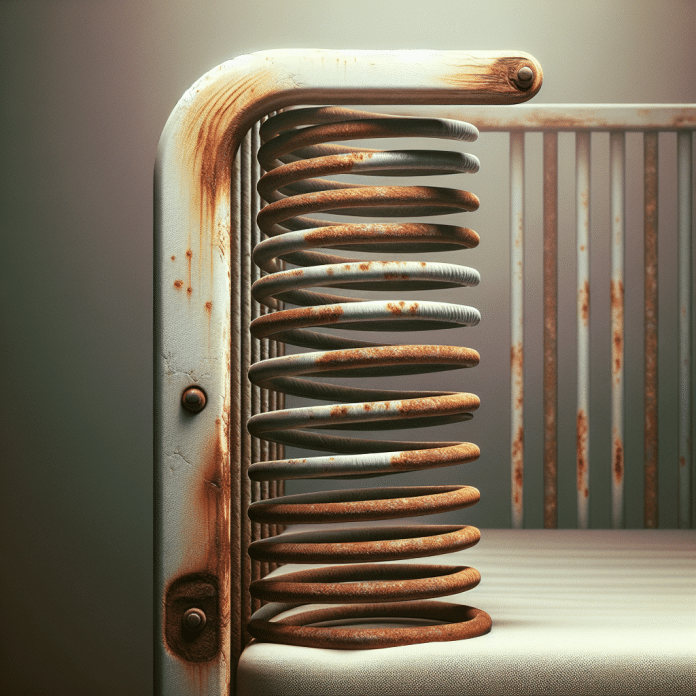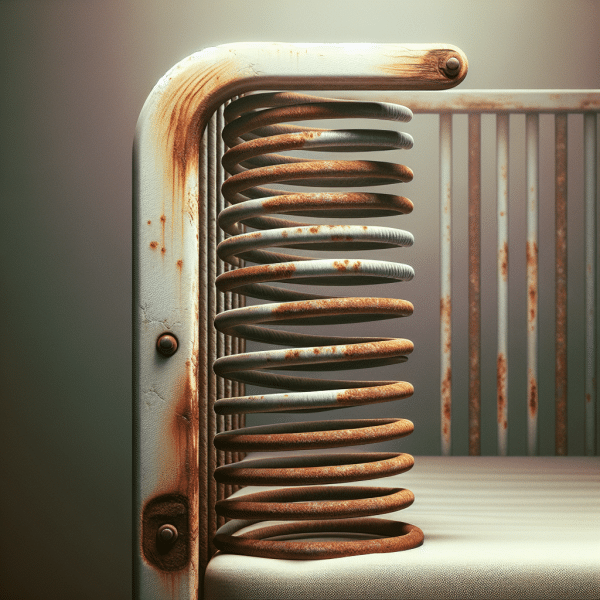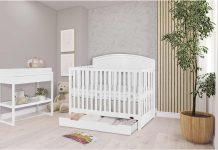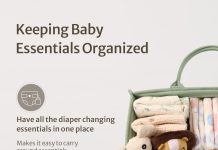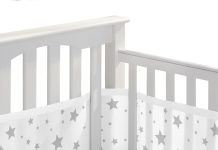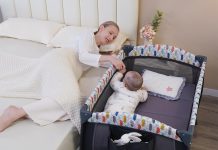As you prepare to bring a new addition to your family into the world, it’s important to consider the safety of their sleeping environment. In this article, we will explore the signs that indicate it may be time to retire that decades-old crib and invest in a new one. By understanding the potential hazards associated with old cribs, you can ensure that your little one gets a good night’s sleep in a safe and secure sleeping space. So, let’s take a closer look at the telltale signs that your cherished heirloom crib may no longer be up to par.
Signs That a Decades-Old Crib Should No Longer Be Used
Review contents
Physical Damage
Loose or broken slats
When inspecting a decades-old crib, one of the first signs to look for is any loose or broken slats. Over time, wooden slats can become weakened or damaged, compromising the overall stability and safety of the crib. If the slats are loose or have visible cracks, it is a clear indication that the crib may no longer be safe to use.
Missing or damaged hardware
Another important aspect to consider is the condition of the crib’s hardware. Decades-old cribs may have missing or damaged hardware, such as screws, bolts, or hinges, which are crucial for holding the crib together securely. If you notice any hardware that is loose, broken, or missing, it’s a strong indication that the crib should no longer be used.
Cracked or splintered wood
Inspect the crib thoroughly for any signs of cracked or splintered wood. Over time, the wood used in cribs can become weakened, making it more prone to cracking or splintering. Any visible cracks or splinters in the crib’s frame or components can pose a serious safety risk to your child. It is essential to address such issues promptly and refrain from using a crib with damaged or compromised wood.
Worn-out or Deteriorating Parts
Worn-out mattress support
Check the mattress support system of the decades-old crib. Over time, the metal or wooden frame that holds the mattress may become worn-out or weakened due to constant use and the weight placed on it. If you notice any signs of sagging or excessive wear on the mattress support, it is an indication that it may no longer provide adequate support for your child.
Damaged or sagging mattress
In addition to the mattress support system, it’s crucial to inspect the crib’s mattress itself. If the mattress appears to be damaged, sagging, or worn-out, it will not provide the necessary comfort and support for your baby. An unsupportive mattress can lead to discomfort and even potential health issues. It’s important to consider replacing both the mattress support and the mattress if they show signs of wear or damage.
Deteriorated crib frame or base
The overall condition of the crib’s frame or base is an important factor to consider. Over time, decades-old cribs can experience deterioration due to various factors, such as exposure to moisture, pests, or general wear and tear. If you notice any signs of deteriorated or weakened crib frame or base, it is a clear indication that the crib should no longer be used, as it may not be able to provide a safe sleeping environment for your child.
Recalls and Safety Standards
Recalled crib models
Research and check the history of the particular crib model you have. Decades-old cribs may have been subject to recalls due to safety concerns. Manufacturers issue recalls when they discover defects or hazards that could potentially harm the child using the crib. If the crib has a history of being recalled, it’s highly recommended to discontinue its use, as it may pose a considerable risk to your child’s safety.
Non-compliance with current safety standards
Safety standards for cribs have evolved significantly over the years. What may have been considered safe decades ago may not meet current safety guidelines. If a crib does not comply with the current safety standards, it’s indicative that the design and construction may not provide adequate protection for your child. It’s essential to prioritize your child’s safety and opt for a crib that meets the most up-to-date safety requirements.
Outdated safety features
Another aspect to consider when assessing the safety of a decades-old crib is the presence of outdated safety features. Cribs manufactured many years ago may lack key safety features that are now considered standard, such as teething rails or adjustable mattress heights. Outdated safety features can compromise the overall safety and functionality of the crib and should be taken into serious consideration when determining whether or not to continue using it.
Unsafe Spacing
Excessive gap between slats
One of the potential safety concerns with decades-old cribs is the spacing between slats. Older crib models may have wider gaps between slats, which can pose a risk to your child’s safety. Infants can get their heads, limbs, or other body parts stuck between wider gaps, potentially leading to injury or suffocation. It’s important to ensure that the spacing between the slats is within safe limits according to current safety standards.
Incorrectly spaced corner posts
Corner posts that are incorrectly spaced can also be a safety hazard in older cribs. If the corner posts are too far apart or too close together, they can pose a risk of entanglement or strangulation for your child. Check the spacing between the corner posts to ensure it meets current safety guidelines and standards.
Wide openings in crib design
Inspect the crib design for any wide openings that may pose a safety risk. Decades-old cribs may have larger spaces or gaps that could allow an infant’s head or body to slip through, potentially causing injuries. It is crucial to avoid using a crib with wide openings, as they can put your child’s safety at risk.
Lead-based Paint
Presence of lead-based paint
Lead-based paint was commonly used in crib manufacturing before stricter regulations were put in place. If your decades-old crib has chipped or peeling paint, there is a possibility that it may contain lead. Exposure to lead can be extremely hazardous, especially for infants and young children. It’s important to have the crib tested for lead and, if positive, to stop using it immediately to prevent lead poisoning.
Chipped or peeling paint
Even if the crib does not contain lead-based paint, chipped or peeling paint can still pose a risk to your child. Infants often explore their surroundings by putting objects, including crib parts, into their mouths. Ingesting paint chips can lead to poisoning or choking hazards. If your decades-old crib has chipped or peeling paint, it’s important to address the issue promptly and consider discontinuing its use.
Health risks associated with lead exposure
Exposure to lead can have severe health consequences for infants and young children. Lead poisoning can lead to developmental delays, neurological damage, and a range of other health problems. Infants are particularly vulnerable to lead exposure due to their developing bodies and increased hand-to-mouth activity. It is crucial to prioritize your child’s well-being by avoiding the use of decades-old cribs that may contain lead-based paint.
Stability Issues
Wobbly or unstable frame
A stable crib is vital for the safety of your child. Decades-old cribs may experience stability issues due to wear and tear, weakening of joints, or inferior construction materials. If the crib’s frame feels wobbly or unstable, it may not provide a secure sleeping environment for your child. Stability issues should be taken seriously, and if detected, it may be time to retire the crib and consider a safer option.
Uneven or unevenly distributed weight
Inspect the crib for signs of uneven weight distribution. If one side of the crib tends to sag or feels significantly heavier than the rest, it indicates a potential structural problem. Uneven weight distribution can compromise the stability and overall integrity of the crib, making it unsafe for your child. It’s important to have a crib where weight is evenly distributed, ensuring your child’s safety while sleeping.
Weak or damaged joints
Check the joints of the crib for any signs of weakness or damage. Decades-old cribs may have joints that have become weakened over time, compromising the crib’s stability. If you notice any loose, cracked, or damaged joints, it’s an indication that the crib may no longer be safe to use. Weak or damaged joints can result in the crib collapsing or coming apart, posing a significant risk to your child’s safety.
Inadequate Safety Features
Missing or broken drop-side mechanism
Older crib models often featured a drop-side mechanism that allowed easier access to the baby. However, these mechanisms were later found to be unsafe and were phased out due to numerous incidents and accidents. If your decades-old crib still has a drop-side mechanism that is missing or broken, it poses a serious safety hazard. A missing or broken drop-side mechanism can lead to entrapment or suffocation, making it imperative to discontinue the use of such cribs.
Lack of teething rail
A teething rail is an important safety feature in cribs as it protects the baby’s mouth and teeth from coming into direct contact with the crib’s wood. Older cribs might not have a teething rail or may have one that has deteriorated over time. If the decades-old crib lacks a teething rail or if it is damaged, it may pose a risk of injury to your child’s mouth or teeth. Ensure that the crib has a functioning and intact teething rail or consider replacing the crib.
Non-adjustable mattress height
Cribs with adjustable mattress heights can provide added convenience and safety for parents and their growing babies. However, if your decades-old crib has a non-adjustable mattress height, it doesn’t accommodate the changing needs of your child. Being unable to adjust the height as your child grows poses a potential risk, especially when they start to stand up and climb. It is recommended to use a crib with an adjustable mattress height to ensure your child’s safety.
Outdated Design and Construction
Non-standard crib dimensions
Crib dimensions and design have changed over the years to enhance safety. Older cribs may have non-standard dimensions that make it difficult to find suitable or properly fitting mattresses or bedding. Ill-fitting mattresses or bedding can create gaps that pose a risk of entrapment or suffocation for your baby. It is essential to use a crib with standard dimensions that comply with current safety guidelines to ensure the utmost safety for your child.
Unsafe or outdated crib designs
Decades-old cribs may have designs that are now considered unsafe or outdated based on current safety standards. For example, cribs with decorative cutouts or ornamental designs may pose a risk of entrapment or strangulation. It’s important to prioritize your child’s safety by choosing a crib with a design that adheres to modern safety standards, eliminating any potential hazards associated with outdated or unsafe designs.
Inferior construction materials
The construction materials used in older cribs may not meet the same standards as cribs made today. Decades-old cribs may contain materials that are no longer deemed safe due to their potential for toxicity or inadequate strength. If the crib is made from inferior or questionable construction materials, it can compromise its overall safety and structural integrity. It’s important to select a crib made from high-quality, safe materials to ensure the well-being of your child.
Age-related Wear and Tear
Degradation of materials over time
As cribs age, the materials used in their construction can degrade over time. Constant use, exposure to environmental factors, and general wear and tear can all contribute to the deterioration of materials. This degradation can weaken the structure and negatively impact the safety of the crib. If you notice signs of significant wear, tear, or decay in the materials of your decades-old crib, it’s advisable to replace it with a newer, safer option.
Weakening of structural integrity
With the passage of time, the structural integrity of a decades-old crib can diminish. The joints, screws, and other components that hold the crib together may become weaker or less reliable, compromising the overall stability and safety of the crib. If you observe any signs of weakened structural integrity, such as loose joints, creaking sounds, or visible signs of damage, it’s essential to discontinue the use of the crib and consider a safer alternative.
Loss of stability and functionality
As a crib ages, it may lose its stability and functionality. Stability issues can arise due to weakened materials, worn-out components, or structural damage. A crib that is no longer stable poses a serious safety risk to your child. Additionally, years of use can impair the functionality of the crib, such as difficulty adjusting mattress height or locking mechanisms. If your decades-old crib has lost its stability or is no longer functioning properly, it’s time to invest in a safer crib that meets current safety standards.
Personal Experience
Use in multiple generations
It is not uncommon for families to pass down cribs from one generation to the next. While this may have sentimental value, it’s important to consider the safety implications. Technologies and safety standards have evolved significantly, meaning a decades-old crib may not provide the same level of protection as a newer model. Reflect on your personal experience with the crib, including its use by previous generations, and weigh it against the potential safety risks it may pose to your child.
Previous accidents or incidents
Consider any previous accidents or incidents that have occurred with the decades-old crib. If the crib has been involved in any incidents, such as collapses, breakages, or injuries, it indicates a potential safety concern. The occurrence of accidents or incidents should be a significant factor in determining whether or not to continue using the crib to ensure the well-being and safety of your child.
General discomfort or unease
Listen to your intuition. If you feel a sense of discomfort or unease about using a decades-old crib, it’s crucial to take your instincts seriously. Parental instincts are often a valuable source of guidance, especially when it comes to the safety of your child. If you find yourself hesitant or uneasy about using the crib, it may be best to explore safer options that provide you with peace of mind and ensure your child’s safety.
In conclusion, when assessing the safety of a decades-old crib, it’s crucial to carefully examine its physical condition, comply with current safety standards, evaluate spacing and stability, consider the presence of lead-based paint, assess the availability of necessary safety features, review the design and construction, and take into account age-related wear and tear. Additionally, personal experiences, incidents, and intuition play a significant role in making the decision to retire a decades-old crib. Prioritizing your child’s safety is paramount, and choosing a crib that adheres to modern safety standards will provide a secure and comfortable sleeping environment for your little one.

